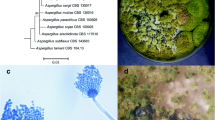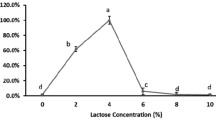Abstract
Aspergillus niger or Aspergillus tamarii when grown as mixed cultures with toxigenic A. flavus inhibits biosynthesis of aflatoxin by A. flavus, owing primarily to its ability to produce inhibitors of aflatoxin biosynthesis and to their ability to degrade aflatoxin. Gluconic acid partly prevents aflatoxin production. The other factors such as changes in pH of the medium and the effect on the growth of A. flavus have no role in imparting capabilities to these cultures to inhibit aflatoxin production by A. flavus.
Similar content being viewed by others
References
Banwort GI (Ed) (1981) Basic Food Microbiology. Westport, Connecticut, AVI Publishing Co. Inc., p. 343
Boller RA & Shroeder HW (1973) Influence of Aspergillus chevalieri on production of aflatoxin in rice by Aspergillus parasiticus. Phytopathology 63: 1507–1510
Boller RA & Shroeder HW (1974) Influence of Aspergillus candidus on production of aflatoxin in rice by Aspergillus parasiticus. Phytopathology 64: 121–123
Coomes TJ, Crowther PC, Feull AJ & Francis BJ (1966) Experimental detoxification of groundnut meals containing aflatoxin. Nature 209: 406–407
Cuero RG, Smith JE & Lacey J (1987) Stimulation by Hyphopichia burtonii and Bacillus amyloliquefaciens of aflatoxin production by A. flavus in irradiated maize and rice grains. Appl. Environ. Microbiol. 53: 1142–1146
Doyle MP & Marth EH (1978a) Aflatoxin is degraded by fragmented and intact mycelia of Aspergillus parasiticus grown 5 to 18 days with and without agitation. J. Food Protection 41: 549–555
Doyle MP & Marth EH (1978b) Aflatoxin is degraded at different temperatures and pH values by mycelia of Aspergillus parasiticus. Eur. J. Appl. Microbiol. and Biotechnol. 6: 95–100
Doyle MP & Marth EH (1978c) Aflatoxin is degraded by heated and unheated mycelia filtrates of homogenized media and filtrates of broth cultures of Aspergillus parasiticus Mycopathologia 64: 59–62
Gardner HK, Koltun SP, Dollear FG & Rayner ET (1971) Inactivation of aflatoxins in peanut and cottonseed meals by ammoniation. J. Am. Oil Chem. Soc. 48: 70–73
Hamid AB & Smith JE (1987) Degradation of aflatoxin by Aspergillus flavus. J. Gen. Microbiol. 133: 2023–2030
Huynh VL & Lloyd AB (1984) Aflatoxin B-1 by young mycelium and its subsequent degradation in aging mycelium Aust. J. Biol Sci. 37: 37–44
Horn BW & Wicklow DT (1983) Factors influencing inhibition of aflatoxin production in corn by Aspergillus niger. Can. J. Microbiology 29: 1087–1091
Kim ST & Kim YB (1986) Effect of some Koji molds on production of aflatoxin by Aspergillus flavus. J. Korean Agric. Chem. 29: 255–259
Ko Swan Djien (1974) Self protection of fermented foods against aflatoxin. Proc. IV Int. Congress Food Sci. and Technol. 3: 244–253
Marshall DL & Bullerman LB (1969) Effect of sucrose esters in combination with selected mold inhibitors on growth and aflatoxin production by Aspergillus parasiticus. J. Food Protection 49: 378–382
Rati ER, Prema V & Shantha T (1987) Modification of Pons' method of estimating aflatoxin B1 in corn, groundnut and groundnut cake. J. Food Sci. and Technol. 24: 90–91
Rati ER & Shantha T (1989) A Novel Device for estimating growth of individual fungus in mixed culture. Indian J. Microbiol 29: 351–354
Rodricks JV, Hesseltine CW & Mehlman MA (Eds) (1977) Mycotoxins in human and animal health. Illinois: Pathotox Publishers, p. 143
Shank RC (1981) Mycotoxins and N-nitroso compounds. Boca Raton, Florida, CRC Press 1:2
Shantha T & Rati ER (1990) Isolation and characterisation of an aflatoxin inhibiting metabolite from A. niger. Current Sci. (in press)
Shantha T, Sreenivasa Murthy V, Rati ER & Prema V (1986) Detoxification of groundnut seeds by urea and sunlight. J. Food Safety 7: 225–231
Smith JE & Pateman JA (Eds) (1977) Genetic and Physiology of Aspergillus. New York, San Francisco, Academic Press, p. 405
Sreenivasa Murthy V, Parpia HAB, Srikanta S & Shankar Murthy A (1967) Detoxification of aflatoxin in peanut meal by hydrogen peroxide. J. Assoc. Off. Anal. Chem. 50: 350–354
Tsubouchi H, Yamamoto K, Hisada & Sakabe Y (1983) Degradation of aflatoxins by Aspergillus niger and aflatoxin nonproducing Aspergillus flavus. Journal of Food Hyg. Soc. Japan Shokuhin Eiseigaku Zasshi 24: 113–119
Wogan GN (1964) Mycotoxins in foodstuffs. Cambridge, Massachusetts, MIT Press p. 18
Yang JO, Lee ST & Kim YB (1988) Aflatoxin degradation by Aspergillus awamori var fumeus. J. Korean Agri. Chem. 31: 182–186
Author information
Authors and Affiliations
Rights and permissions
About this article
Cite this article
Shantha, T., Rati, E.R. & Bhavani Shankar, T.N. Behaviour of Aspergillus flavus in presence of Aspergillus niger during biosynthesis of aflatoxin B1 . Antonie van Leeuwenhoek 58, 121–127 (1990). https://doi.org/10.1007/BF00422728
Received:
Accepted:
Issue Date:
DOI: https://doi.org/10.1007/BF00422728




